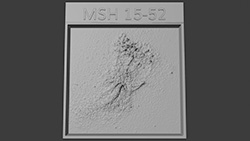CXC Home | Search | Help | Image Use Policy | Latest Images | Privacy | Accessibility | Glossary | Q&A
1
X-ray & Infrared Images of MSH 15-52Credit: X-ray: NASA/CXC/Stanford Univ./R. Romani et al. (Chandra); NASA/MSFC (IXPE); Infared: NOIRLab/DECam; Image Processing: NASA/CXC/SAO/J. Schmidt
By combining data from Chandra and IXPE, astronomers are learning more about how a pulsar is injecting particles into space and shaping its environment. The X-ray data are shown along with infrared data from the Dark Energy Camera in Chile. Young pulsars can create jets of matter and antimatter moving away from the poles of the pulsar, along with an intense wind, forming a “pulsar wind nebula”. This one, known as MSH 15-52, has a shape resembling a human hand and provides insight into how these objects are formed.
2
3D Printable Files: MSH 15-52 (X-ray Only)(3D Print Credit: NASA/CXC/A. Jubett, using software by Tactile Universe/N. Bonne & C. Krawczyk & Blender)
This tactile plate is a physical relief map based on the intensity of X-ray data of a pulsar wind nebula, which strongly resembles a ghostly hand with sparkling fingertips.
A pulsar is a highly magnetized collapsed star that rotates and creates jets of matter flowing away from its poles. These jets, along with intense winds of particles, form pulsar wind nebulae. Here, the pulsar wind nebula known as MSH 15-52 resembles a cloud set against a sparse backdrop.
Both NASA’s Chandra X-ray Observatory and the Imaging X-ray Polarimetry Explorer (IXPE) have observed MSH 15-52. Their observations revealed that the shape of this pulsar wind nebula strongly resembles a human hand, including five fingers, a palm and wrist. The blobby spot near the base of the palm is the pulsar itself.
The three longest fingertips of the hand-shape point toward our upper right, or 1:00 on a clock face. There, a small, mottled cloud appears to sparkle like embers. This cloud is part of the remains of the supernova explosion that created the pulsar.
A pulsar is a highly magnetized collapsed star that rotates and creates jets of matter flowing away from its poles. These jets, along with intense winds of particles, form pulsar wind nebulae. Here, the pulsar wind nebula known as MSH 15-52 resembles a cloud set against a sparse backdrop.
Both NASA’s Chandra X-ray Observatory and the Imaging X-ray Polarimetry Explorer (IXPE) have observed MSH 15-52. Their observations revealed that the shape of this pulsar wind nebula strongly resembles a human hand, including five fingers, a palm and wrist. The blobby spot near the base of the palm is the pulsar itself.
The three longest fingertips of the hand-shape point toward our upper right, or 1:00 on a clock face. There, a small, mottled cloud appears to sparkle like embers. This cloud is part of the remains of the supernova explosion that created the pulsar.
Return to: X-ray Telescopes Reveal the "Bones" of a Ghostly Cosmic Hand (October 30, 2023)








